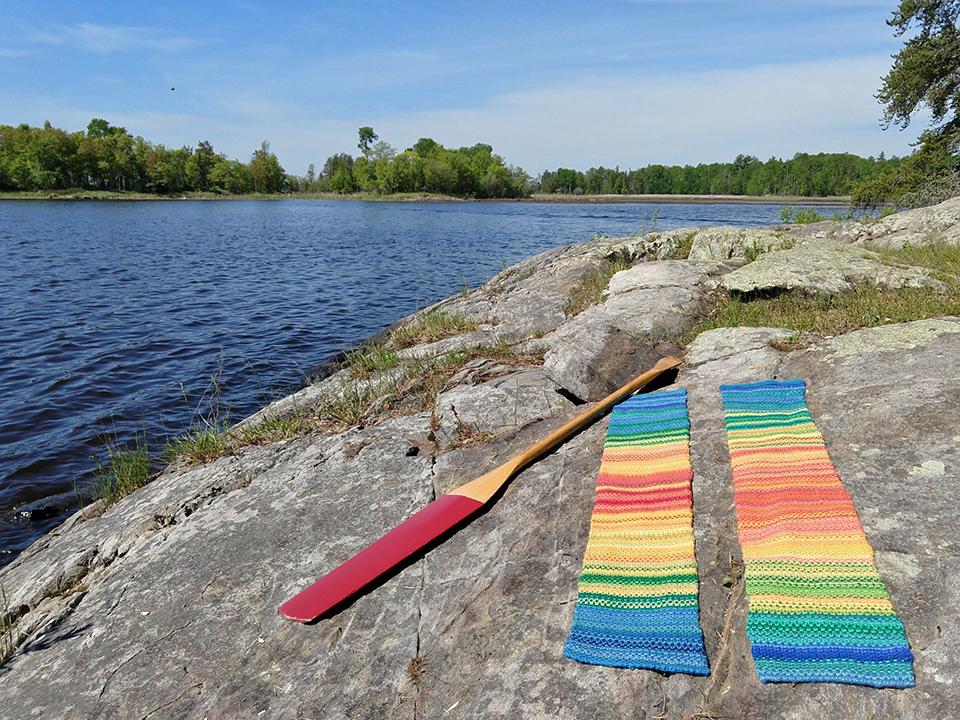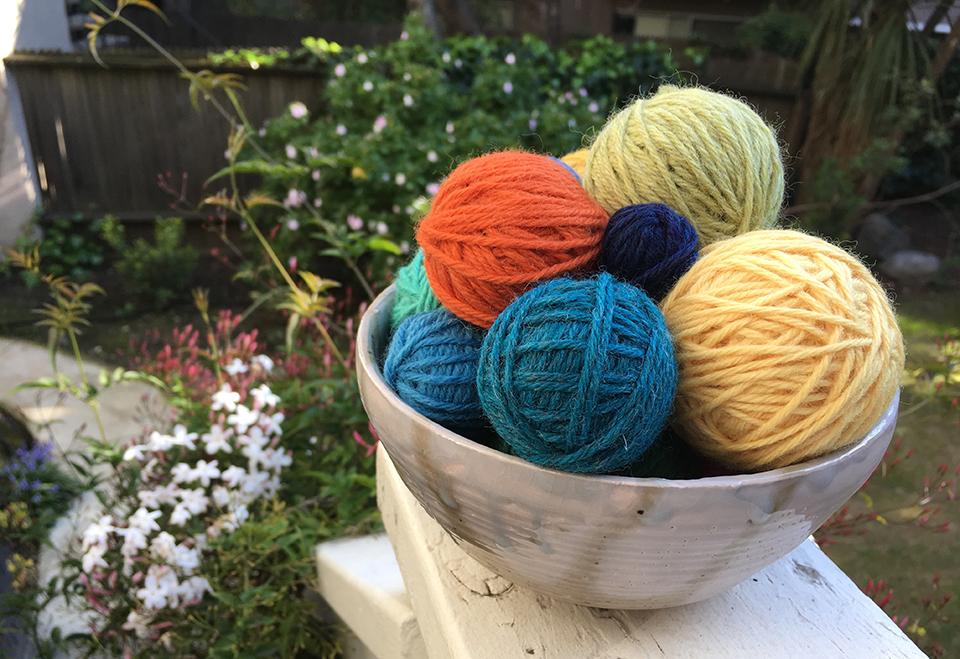
Two tempestries knitted by Deb Ceci, 1975 on the left, 2016 on the right. Photo by the Voyageurs National Park Association.
The two tempestries had arrived in the mail, one depicting 1975 at Voyageurs National Park, the other, 2016. Comprised of all the colors of the rainbow and knit neatly by Deb Ceci, each row of the crafted work represents one day of high temperature data over the course of a year.
Staff at the Voyageurs National Park Association spread the two tempestries on the rocks next to the water of the Minnesota park, aligned perfectly with a wooden canoe paddle. From the photo, the tempestries have an obvious story to tell: 2016 experienced a generally hotter summer.
The National Parks Tempestry Project, first discussed on NPT here, began in the winter of 2019. Collaborating with the Tempestry Project team, we have reached out to over 100 crafters across the United States to create tempestries for over 100 National Park sites, from the iconic Everglades and Yosemite to the Carl Sandburg National Historic Site, Pipestone National Monument, and more.
At first, we mainly recruited knitters and crocheters from our own social circles and from the Tempestry Project Facebook group, but sign-ups snowballed when famed crafter Karen Templer shared the NPT article on her popular blog. Today, over 50 kits have already been sent out, with more slated for the future. Though the sign-up period has ended, the knitting, crocheting, and stitching continues at a breakneck speed. While Deb Ceci’s tempestries were the first completed, others soon followed suite.
For me, the National Park Tempestry project has been a way to connect to my friends and family with a climate change project. During the sign-up phase, I called Stephanie. She and I attended graduate school together, specializing in ecosystem science and bonding over birding and an affinity for crafts. While I began knitting at nine, Stephanie pursued stitching in high school, completing a simple scarf and mastering basic skills before returning to yarn in earnest during her master’s degree studies. Though she hails from California and I live across the country in Florida, she and I speak online nearly every day about our jobs, our friends, current events, and, of course, knitting.
Stephanie signed up for Glacier National Park in Montana, while my kits for Florida’s Gulf Islands National Seashore arrived just a few weeks later. Though the sites represent a stark contrast in temperature and ecosystem, they remain easily comparable thanks to the forethought provided by Justin, Emily, and Marissa at the Tempestry Project. Since 2016, they have sent out over 400 tempestry kits every year so people can explore not only climate, but also important years and places in their own lives.

Yarn for the Glacier National Park tempestries. Photo by Stephanie Panlasigui.
“I felt compelled to join this project because I thought a tempestry was a great conversation starter,” Stephanie explained, “In fact, my ongoing project sparked conversation with my family (in which I am the only environmental scientist), not only about what a tempestry is, but also what a changing climate means, and how the accumulation of data over many years shows that change.”
She continues, “The completed projects are vibrant, beautiful, and tangible. You can pick up one year and lay it next to another year to compare. You can run your fingers over the days and changes in season, and find birthdays and anniversaries.”
Stephanie’s kit is one of the handful funded by friends’ of groups and nonprofit associations founded to help individual parks. At the end of the initiative, her tempestries will go back to the Glacier National Park Conservancy to be used to illustrate changes in the park over time. Similarly, the Friends of Acadia organization has sponsored their own kits, while other associations are aiding in the photographing of the tempestries in the parks themselves.
As summer continues, the National Park Tempestry Project has moved from the sign-up to the coordination phase, as finished tempestries are shipped cross-country to be photographed in the parks they represent. When all are complete, the tempestries will be hung within in-person galleries, and eventually compiled into a book.
Knitting, as an art form, is both process and product. As the cohort of crafters makes slow progress on each tempestry kit, we exchange questions and answers, memories and hopes, finished projects and those just beginning. By the end of this project, we will create over 200 tempestries that will represent over 73,000 days of data. Not only that, we are also creating a community that brings human connection to the climate change discussion, as we talk about how the 21st century will change places we love.



Comments
I would enjoy knitting a Tempestry for a National Park. Has anyone considered making them every year. I really like the colors used. Is the color code available to others?
what is the process for participating in the project? I am a weaver in SW NM. Gila Cliff Dwelling NM is right up the road.
Hi there! We are not currently accepting any more volunteers until we work through this batch of 50+, but I'll let you know when it changes!
Hi there! Yes the color code is available on the Tempestry website, and they provide instructions on the type of yarn they use too.
Beautiful! I'd better get knitting. Lassen Volcanic Park will be inprogress soon!